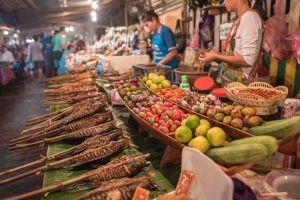Inflation continues to spiral out of control in Laos, with the country’s Statistics Bureau announcing this week that the country’s year-on-year inflation had risen to a 22-year high of 23.6 percent in June. According to a report in the state-run Vientiane Times, the consumer price index last month jumped sharply above the ceiling rate of 12 percent set by the government, which was already breached last month, when year-on-year inflation touched 12.8 percent.
The alarming inflation figures are the latest indication of the economic storm that continues to batter the country’s debt-laden economy. In recent months, Laos has been exposed to the twin shocks of rising oil prices and a rapidly depreciating currency, which have led to runaway increases in the price of energy and consumer goods. The local currency, the kip, has collapsed in value. As recently as September, one U.S. dollar traded for just over 9,300 kip, a rate that has since blown out to around 15,000.
As a result, the Vientiane Times reported that the price of petrol, gas and gold had increased 107.1 percent, 69.4 percent, and 68.7 percent, respectively, in the year to June. It also reported that “the cost of food, seasonings, non-alcoholic beverages, clothes, footwear, medicine, construction equipment, vehicles, spare parts, and other imported goods rose significantly.” In the words of the usually staid newspaper, these upward pressure “continue to deepen hardship and create new pains for the Lao public.”
The fuel price crisis has been perhaps the most visible indicator of economic crisis, with motorists forced to queue up for hours in the capital Vientiane in May due to fuel shortages caused by the government’s lack of available foreign exchange. With diesel rising by similar margins to petrol, the fuel crisis threatens also to bring agricultural production to a halt, as farmers struggle to keep the necessary machinery running.
Looming in the background is the question of debt. Laos currently owes $13.3 billion in sovereign debt, much of which has financed the construction of large-scale infrastructure projects, many backed by China, including the undeniably impressive but costly high-speed railway connecting Vientiane to the Chinese border. After COVID-19 hit the country in 2020, draining its foreign reserves and leaving it at high risk of default.
As The Diplomat’s David Hutt noted recently, the economic crisis is now beginning to attain a political dimension. Last month, Prime Minister Phankham Viphavanh was forced to reshuffle his cabinet in a bid to get the economic situation under control. On June 6, Phankham belatedly formed a special taskforce to address the country’s economic problems, in particular, to resolve its fuel shortages.
The nation has since seen a temporary reprieve from the fuel crisis after the government issued a line of credit to state fuel importers, allowing them to import enough fuel to keep the country running until the end of August. The government has also raised the national minimum wage in order to assist those most affected by the rising cost of living.
But these are best seen as piecemeal measures that will do little to resolve the structural challenges facing the economy. These include rampant corruption and tax evasion, which by the government’s own admission have starved the state of revenue, and an infrastructure-driven development strategy that has left the country both exposed to external shocks and highly indebted to a single creditor (China).
Laos’ government will no doubt introduce more measures to stave off the worst impacts of the crisis on ordinary people, but a more lasting solution to the country’s economic woes appears some way off.

































